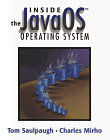A Definitive Guide to JavaOS for Business
Insider coverage of this emerging network device technology, with information that's unavailable anywhere else.
ORIGINAL DRAFT
Sun has talked a lot about JavaOS for network computing and small devices. Despite the many press releases and project announcements, its not that easy to get the scoop on this new technology, unless you’re partnered with Sun on a hardware project. Written by two JavaOS project insiders, this book parts the curtain and provides a walking tour of the JavaOS technology in a manner both informative and revealing. The authors fully realize that operating systems are rarely widely adopted in their first two incarnations and concentrate on the second version features of JavaOS, co-developed with IBM and named "JavaOS for Business".
The JavaOS is divided into two major component groups, effectively, the runtime and non-runtime components. The major low-level components are the JPI (Java Platform Interface), booter and Microkernel. The runtime components include the system database, the event system, service loader and device drivers. Chapter 1 provides an architectural overview of the JavaOS system and helps explain these components and their place in the scheme of things. Each subsequent chapter takes a closer look at the major components, digging deeper into their purpose and the way they function.
Interestingly enough the authors start explaining the subsystems from the top down. Chapter 2 covers the system database, with Chapter 3 exploring the event system, chapter 4 the service loader and Chapter 5 covering standard device support. Chapter 6 looks at device drivers, the division between basic and bus devices, and how exceptions are handled, providing an example serial port driver. Memory handling is covered in Chapter 7, Interrupt Handling in Chapter 8, the Microkernel in Chapter 9 and Booting in Chapter 10. Taken together, these chapters will help you gain a fairly deep appreciation for the internals of JavaOS and how these capabilities can be applied to real-world projects.
No other book explores the JavaOS as completely as this one. The authors provide insights that only project insiders could offer, ranging from the time of conception to recent deployment choices and even technology adoption patterns. Each chapter covers an important part of the JavaOS, opening concepts before the reader, like the pealing back of a small round onion. JavaOS is fully compatible with the Java 1.1 Development Kit, so some of the basic ideas are immediately applicable outside the JavaOS environment. If you believe small devices will proliferate and that JavaOS is central to that success, you should expect to be developing under JavaOS in the future. Buying this book can put you ahead of a potentially lucrative curve.
